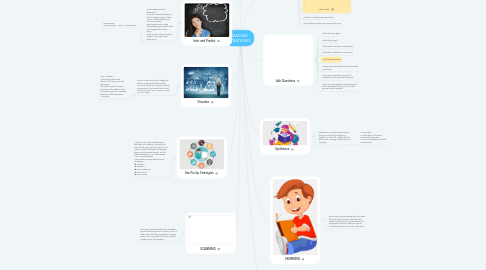READING STRATEGIES
by Gabriel González Cuadros


1. Determine Importance
1.1. Determine Importance Pick and choose which details are the most important to remember. •Think about what a teacher might ask on a test. •Think about what the author hints might be important later on.
2. Infer and Predict
2.1. Good readers are like detectives. They use clues to determine what is happening in a story. This is called INFERENCE! Infer and Predict Good readers also make educated guesses about what may happen later in the story. They use the author’s hints to PREDICT what will most likely occur.
2.1.1. REMEMBER: KNOWLEDGE + TEXT = INFERENCE
3. Visualize
3.1. -Picture in your mind the images the author creates with his/her words. -Pay close attention to sensory details. For example, if you were there, what would you SEE, HEAR, SMELL, TASTE, TOUCH, FEEL?
3.1.1. Why Visualize? If you don’t picture the events of the story, you will get bored. The author’s job is to paint pictures in the reader’s mind. The reader’s job is to visualize what the author describes. Why not?
4. Use Fix Up Strategies
4.1. Make sure you are understanding what you are reading. When you run into trouble, (you just don’t get it), use little correction strategies to help you figure out what went wrong. We call these methods FIX UP STRATEGIES. Use Fix Up Strategies Here are some examples of Fix Up Strategies: ☻ Re-read ☻Underline ☻Use a Dictionary ☻Read Aloud ☻Ask for Help
5. SCANNING
5.1. Scanning involves searching for numbers, symbols and long words in a text. This is a useful way of locating answers in reading exams. You can scan the text for words or numbers from the question.
6. Make Connections
6.1. Text to Self (similar events in your life)
6.2. Text to Text (books, movies, T.V., etc.)
6.3. Text to Life (real world events)
6.4. Ask Yourself:
6.5. What do I already know about this?
6.6. Has anything similar ever happened to me?
7. Ask Questions
7.1. What don’t you get?
7.2. What do you get?
7.3. What words don’t you understand?
7.4. What other questions do you have?
7.5. Why Ask Questions?
7.6. Asking questions helps keep you focused on the text.
7.7. If your mind wanders, you will not understand. Then you will be bored.
7.8. If you run into problems, things you just don’t understand, then you can check yourself with a question.
8. Synthesize
8.1. Synthesize is a fancy way of saying that you must bring everything together in the end. In other words, what is the meaning of what you are reading?
8.1.1. Ask Yourself: o What does it all mean? oWhat’s the big idea? o Are there questions still left unanswered?
